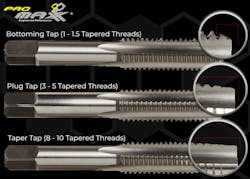If you’ve worked on a car repair at home or in any automotive, industrial, or fabricator shop before you may know a tap is a common yet overlooked hand tool. Machining technologies have advanced and common taps have become more specific in use and in care. Learn about taps in their basic and complex forms and how they are used below.
Tap grades
First, breaking taps into three different layman-type grades is essential to make sure you have the right tool for the right job. Machine grade, the best most accurate and sharpest of the bunch, is the number one choice for any repair that calls for precision, quality, and productivity. Machine grade taps also demand a higher purchase price as they are cut and machined to precision tolerances that allow the tap to cut to a predetermined depth of thread. Loose fasteners will lose their holding strength, but a fastener that fits too tightly will fail to engage properly. Machine grade taps are also capable of high machine speeds in CNC lathes and milling machines. They are used to cut many holes consecutively and at higher feed rates. In fact, holes per minute and can last much longer holding an edge for continued use and repeatability.
Medium grade taps are often found in jobber warehouse-type stores and are of generally a good quality multi-purpose use. Best used in hand applications and where tap life and precision are not as important as availability and cost.
Quality entry-level grade taps are usually found in hardware stores and are best used for hand applications. However, they have a limited life and are less tolerant of misalignment of tap with bore.
Tap use
A tap is used to make (cut) new threads or clean out (chase) existing threads in a screw mechanism. Though this tool is most commonly used by machinists and engineers, automotive technicians may also have a tapping set in their toolbox. There are dozens of situations where having a solid knowledge and appreciation for the science behind tapping threads into a piece of machinery can prevent hours of troublesome work and hundreds of dollars in replacement parts.
Types of taps
There are three main types of taps to be familiar with taper, plug, and bottoming taps.
1. Taper tap
The taper tap can be identified by the visible and pronounced tapering of the cutting edges. This provides a very gradual and less aggressive cutting action. The distinct feature of a taper tap is the 8 to 10 threads that taper from the tip to the full cutting force diameter. A taper tap is most often used as a starter tap for difficult blind holes. The gentle taper of the cutting edge is the most forgiving when tapping by hand and allows for a straight hole to be cut in especially hard materials.
A taper tap is rarely the final tap used before completing a project, however, as the taper leaves incomplete threads cut at the bottom of a blind hole.
2. Plug tap
A plug tap has a less pronounced taper to the cutting edges. This gives the plug tap a gradual cutting action that is less aggressive than that of the bottoming tap but more aggressive than a taper tap. Typically, the plug tap will have 3 to 5 tapered threads before the full cutting diameter is engaged.
Plug taps are great when used with through-holes, as they are almost as easy as taper taps to start, but also offer a more complete set of threads.
3. Bottoming tap
The third style is a bottoming tap. Bottoming taps have 1 to 2 tapered cutting edges before the full cutting force is engaged. Though this tap is extremely hard to start threads with, it is capable of cutting threads all of the way to the bottom of a blind hole. Bottoming taps are best used after a taper or plug tap has been used to cut the initial thread.
Spiral vs straight flute taps
Spiral flute taps can be a great tool for cutting through softer metals and metals that do not chip (such as cast iron). The spiral flutes work just like that of a traditional drill bit, promoting the evacuation of cut material from the hole. The downside of spiral flute taps is their strength. Being that deep flutes are cut into the tap, the cross-section of the cutting web is not as thick as that of a straight flute tap.
Straight flute taps are a robust cutting tool with flutes that run straight down the shaft of the tap. The larger cross-section of the cutting edge makes the straight flute tap a great solution for cutting threads into hardened metals. When cutting or cleaning threads in a blind hole, the technician needs to be patient while using this tool, let the cutting edge do the work, and continually back the tap out and blow air into the hole to evacuate the removed material. A buildup of chips below the straight flute tap will lead to breakage and less clean-cut threads.
Choosing the right tap always depends on the type of hole you are trying to cut or clean, as well as the type of material you are tapping. If you are using a guide plate and guide bushing like that of a ProMAXX ProKit, we recommend using the aggressive and complete cutting action of the bottoming tap. If you are tapping free hand, you will want to start with a taper tap then work your way up to the complete cutting action of the bottoming tap.
Information provided by ProMAXX
About the Author

Chris Novak
Marketing Manager - ProMAXX
A Western PA native with professional experience developing marketing and communication plans for a number of industries: healthcare, financial services, agency, and manufacturing. Novak drives the ProMAXX Tool marketing strategy by engaging with technicians and industry leaders on digital media platforms and stopping by local shops and tool trucks to see what tools technicians really need.
